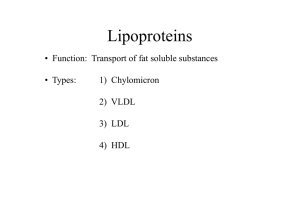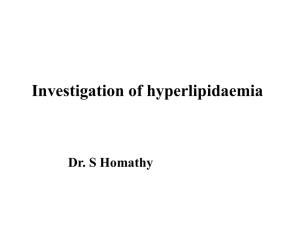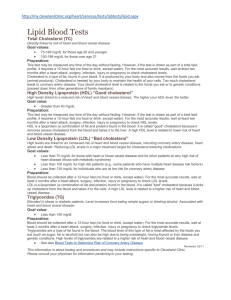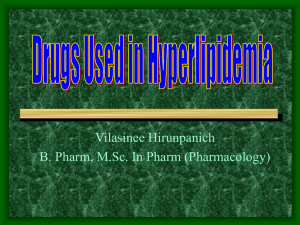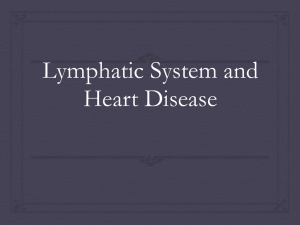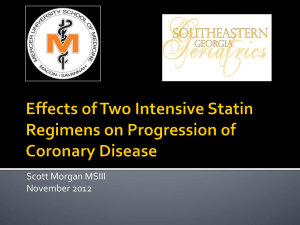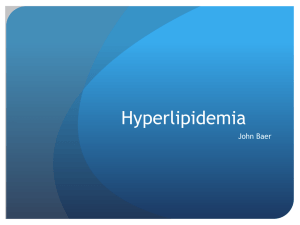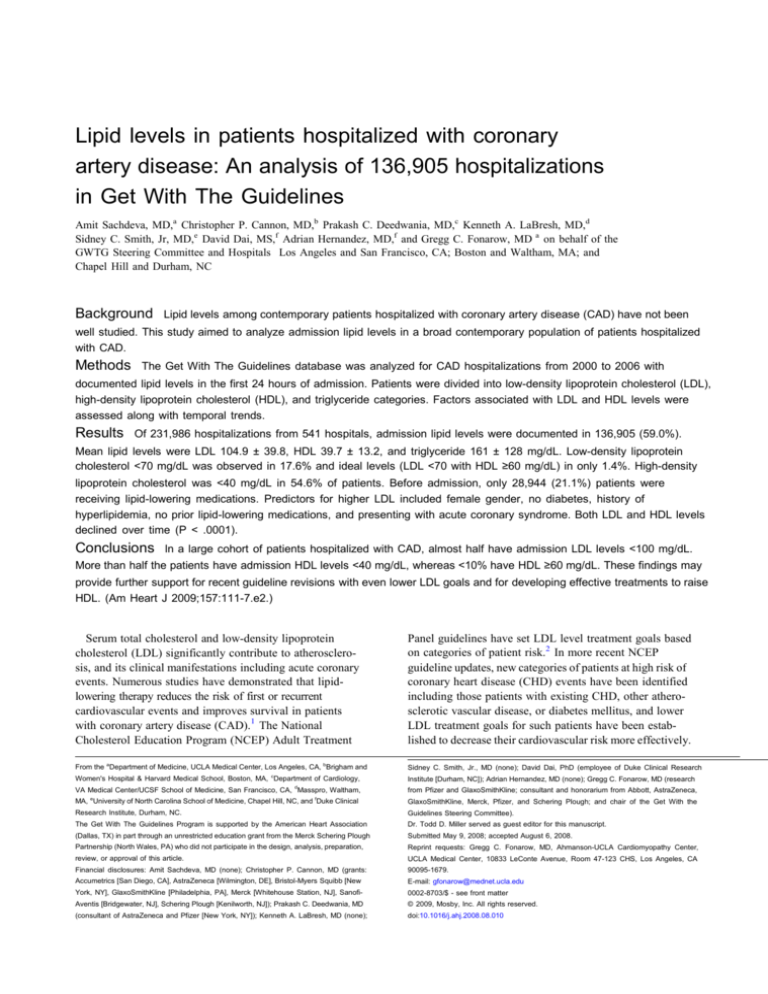
Lipid levels in patients hospitalized with coronary
artery disease: An analysis of 136,905 hospitalizations
in Get With The Guidelines
Amit Sachdeva, MD,a Christopher P. Cannon, MD,b Prakash C. Deedwania, MD,c Kenneth A. LaBresh, MD,d
Sidney C. Smith, Jr, MD,e David Dai, MS,f Adrian Hernandez, MD,f and Gregg C. Fonarow, MD a on behalf of the
GWTG Steering Committee and Hospitals Los Angeles and San Francisco, CA; Boston and Waltham, MA; and
Chapel Hill and Durham, NC
Background
Lipid levels among contemporary patients hospitalized with coronary artery disease (CAD) have not been
well studied. This study aimed to analyze admission lipid levels in a broad contemporary population of patients hospitalized
with CAD.
Methods
The Get With The Guidelines database was analyzed for CAD hospitalizations from 2000 to 2006 with
documented lipid levels in the first 24 hours of admission. Patients were divided into low-density lipoprotein cholesterol (LDL),
high-density lipoprotein cholesterol (HDL), and triglyceride categories. Factors associated with LDL and HDL levels were
assessed along with temporal trends.
Results
Of 231,986 hospitalizations from 541 hospitals, admission lipid levels were documented in 136,905 (59.0%).
Mean lipid levels were LDL 104.9 ± 39.8, HDL 39.7 ± 13.2, and triglyceride 161 ± 128 mg/dL. Low-density lipoprotein
cholesterol <70 mg/dL was observed in 17.6% and ideal levels (LDL <70 with HDL ≥60 mg/dL) in only 1.4%. High-density
lipoprotein cholesterol was <40 mg/dL in 54.6% of patients. Before admission, only 28,944 (21.1%) patients were
receiving lipid-lowering medications. Predictors for higher LDL included female gender, no diabetes, history of
hyperlipidemia, no prior lipid-lowering medications, and presenting with acute coronary syndrome. Both LDL and HDL levels
declined over time (P < .0001).
Conclusions
ln a large cohort of patients hospitalized with CAD, almost half have admission LDL levels <100 mg/dL.
More than half the patients have admission HDL levels <40 mg/dL, whereas <10% have HDL ≥60 mg/dL. These findings may
provide further support for recent guideline revisions with even lower LDL goals and for developing effective treatments to raise
HDL. (Am Heart J 2009;157:111-7.e2.)
Serum total cholesterol and low-density lipoprotein
cholesterol (LDL) significantly contribute to atherosclerosis, and its clinical manifestations including acute coronary
events. Numerous studies have demonstrated that lipidlowering therapy reduces the risk of first or recurrent
cardiovascular events and improves survival in patients
with coronary artery disease (CAD).1 The National
Cholesterol Education Program (NCEP) Adult Treatment
Panel guidelines have set LDL level treatment goals based
on categories of patient risk.2 In more recent NCEP
guideline updates, new categories of patients at high risk of
coronary heart disease (CHD) events have been identified
including those patients with existing CHD, other atherosclerotic vascular disease, or diabetes mellitus, and lower
LDL treatment goals for such patients have been established to decrease their cardiovascular risk more effectively.
From the aDepartment of Medicine, UCLA Medical Center, Los Angeles, CA, bBrigham and
Sidney C. Smith, Jr., MD (none); David Dai, PhD (employee of Duke Clinical Research
Women's Hospital & Harvard Medical School, Boston, MA, cDepartment of Cardiology,
Institute [Durham, NC]); Adrian Hernandez, MD (none); Gregg C. Fonarow, MD (research
VA Medical Center/UCSF School of Medicine, San Francisco, CA, dMasspro, Waltham,
from Pfizer and GlaxoSmithKline; consultant and honorarium from Abbott, AstraZeneca,
e
f
MA, University of North Carolina School of Medicine, Chapel Hill, NC, and Duke Clinical
GlaxoSmithKline, Merck, Pfizer, and Schering Plough; and chair of the Get With the
Research Institute, Durham, NC.
Guidelines Steering Committee).
The Get With The Guidelines Program is supported by the American Heart Association
Dr. Todd D. Miller served as guest editor for this manuscript.
(Dallas, TX) in part through an unrestricted education grant from the Merck Schering Plough
Submitted May 9, 2008; accepted August 6, 2008.
Partnership (North Wales, PA) who did not participate in the design, analysis, preparation,
Reprint requests: Gregg C. Fonarow, MD, Ahmanson-UCLA Cardiomyopathy Center,
review, or approval of this article.
UCLA Medical Center, 10833 LeConte Avenue, Room 47-123 CHS, Los Angeles, CA
Financial disclosures: Amit Sachdeva, MD (none); Christopher P. Cannon, MD (grants:
90095-1679.
Accumetrics [San Diego, CA], AstraZeneca [Wilmington, DE], Bristol-Myers Squibb [New
E-mail: gfonarow@mednet.ucla.edu
York, NY], GlaxoSmithKline [Philadelphia, PA], Merck [Whitehouse Station, NJ], Sanofi-
0002-8703/$ - see front matter
Aventis [Bridgewater, NJ], Schering Plough [Kenilworth, NJ]); Prakash C. Deedwania, MD
© 2009, Mosby, Inc. All rights reserved.
(consultant of AstraZeneca and Pfizer [New York, NY]); Kenneth A. LaBresh, MD (none);
doi:10.1016/j.ahj.2008.08.010
American Heart Journal
112 Sachdeva et al
A number of studies have suggested that total
cholesterol and LDL levels have been decreasing in the
general US population.3 Although lipid levels and
temporal trends in the general population have been well
studied, lipid levels among contemporary patients
hospitalized with CAD have not. This study analyzed data
from the American Heart Association's Get With The
Guidelines (GWTG) CAD Program from 2000 to 2006. A
broad cohort of patients hospitalized with CAD among
participating hospitals in which lipid levels were
obtained within the first 24 hours of admission were
studied. The proportion of patients falling into each NCEP
category for LDL, high-density lipoprotein cholesterol
(HDL), and triglycerides were assessed, overall and for
clinically relevant subgroups, as well as factors associated
with admission lipid levels. Temporal trends during the
period of the study were also analyzed.
Methods
Details of GWTG CAD have been previously published.4 In
brief, the American Heart Association (Dallas, TX) launched the
GWTG program to support and facilitate the improvement of
the quality of care of patients with cardiovascular disease. Get
With The Guidelines uses a Web-based patient management tool
(Outcome Sciences Inc, Cambridge, MA) to collect clinical data,
provide decision support, and provide real-time online reporting
features. Data collected included patient demographics, medical
history, symptoms on arrival, results of laboratory testing, inhospital treatment and events, discharge treatment and counseling, and patient disposition. Outcome Sciences, Inc, serves as
the data collection and coordination center for GWTG.
Patient population
This study includes patients enrolled from the 541 hospitals
participating in GWTG-CAD program that includes teaching and
nonteaching, rural and urban, and large and small hospitals
from all census regions of the United States. The patient
population included patients hospitalized with confirmed
clinical diagnoses of CAD, including patients with acute
coronary syndromes, stable CAD hospitalized for revascularization, and patients with documented CAD hospitalized for
reasons other than heart failure. Case finding was based on
clinical identification of patients with CAD diagnoses or Joint
Commission International Classification of Diseases, Ninth
Revision identification of CAD diagnoses with clinical verification for data abstraction.
Data were collected on patients hospitalized at participating
hospitals between January 1, 2000, and April 30, 2006. The data
elements collected had written definitions and were gathered
using common specifications for all participants. Using the
internet-based system, data quality was monitored, and reports
were generated to assure the completeness and accuracy of the
submitted data. All participating institutions were required to
comply with local regulatory and privacy guidelines and to
submit the GWTG protocol for review and approval by their
institutional review board. Because data were used primarily at
the local site for quality improvement, sites were granted a
waiver of informed consent under the common rule. The Duke
January 2009
Clinical Research Institute (Durham, NC) serves as the data
analysis center and analyzed the aggregate deidentified data for
research purposes.
Patient characteristics, quality of care, and in-hospital
procedures data were collected and included demographics,
past medical history, use of lipid-lowering medications as an
outpatient before hospitalization, cardiac diagnosis of patients
on presentation, vital signs, admission laboratories, cardiac
procedures, and discharge quality of care measures. Lipid levels
obtained within the first 24 hours of admission were as analyzed
by the local hospital laboratory and as recorded in the medical
record. The study population included patients with CAD in the
database with lipid levels documented in the first 24 hours of
admission. Patients with heart failure (n = 38,579) were
excluded from the study.
Statistical analysis
Patients were divided into categories based on admission lipid
levels: LDL <70, 70-100, 100-130, 130-160, and ≥160 mg/dL;
HDL <40, 40-60, and ≥60 mg/dL; and triglyceride <150 and
≥150 mg/dL. Wilcoxon rank sum tests were used for continuous
variables and χ2 tests for categorical variables. The mean (±SD)
and percentages were reported for continuous and categorical
variables, respectively. The Kruskal-Wallis test was used to
compare temporal trends in lipid levels. Multivariable regression
analysis using Generalized Estimation Equations (GEE) was
performed to determine patient characteristics predictive of
LDL and HDL levels. The GEE approach adjusts for patient
demographics and baseline clinical status and considers the
clustering effect within hospitals. Patient age, gender, race, body
mass index, medical history (hypertension, dyslipidemia,
diabetes, renal insufficiency, prior myocardial infarction [MI],
smoking, heart failure, and stroke), admission diagnoses, and
prior use of lipid-lowering medications were included initially in
the multivariable model, and then factors for which P ≥ .05
were removed from the logistic regression model. A P of <.05
was considered significant for each test. Multivariable analyses
were also performed for variables predictive of LDL ≥100 mg/dL
and HDL <40 mg/dL. All analyses were performed using SAS
software (version 8.2, SAS Institute Inc, Cary, NC).
Results
During the 76 months of the study in 231,896 CAD
hospitalizations from 541 hospitals, lipid levels were
obtained in the first 24 hours of hospitalization in
136,905 (59.0%). Patients with and without lipid levels
obtained on admission showed modest differences: age
(65 vs 69 years), female sex (63% vs 59%), prior CHD,
other atherosclerotic vascular disease, or diabetes (46%
vs 40%), and treatment with lipid-lowering medications
before hospitalization (21% vs 16%). The clinical
characteristics of the patients with documented admission lipid levels are listed in Table I. The mean age of the
population was 65 ± 14, and 62.7% were male. The
cohort were 65.2% white, 6.7% black, 5.7% Hispanic,
and 2.3% Asian. Cardiovascular risk factors and comorbidities were frequently present with 54.2% having
hypertension, 26.2% having diabetes, and 30.4% being
American Heart Journal
Sachdeva et al 113
Volume 157, Number 1
Table I. Patient characteristics of the study population
Patient characteristics
Age (y)
Female
Race/Ethnicity
White
Black
Hispanic
Asian
Not documented
Diagnosis
STEMl/NSTEMl
Unstable angina
CAD
Angina
Prior myocardial infarction
Peripheral vascular disease
Prior Stroke
Diabetes mellitus
Prior CHD, other vascular disease, or diabetes
Hypertension
Hyperlipidemia history
Prior use of lipid-lowering medications
Smoking (current or prior 1 y)
Renal insufficiency
Renal dialysis (within past 3 mo)
Chronic obstructive pulmonary disease
History of atrial fibrillation
Body mass index (kg/m2)
Admission systolic blood pressure (mm Hg)
Total cholesterol (mg/dL)
LDL cholesterol (mg/dL)
HDL cholesterol (mg/dL)
Triglycerides (mg/dL)
Figure 1
Value
65 ± 14
36.3%
65.2%
6.7%
5.7%
2.3%
20.1%
75.0%
4.5%
11.3%
13.1%
16.5%
6.6%
6.6%
26.2%
45.6%
54.2%
35.5%
21.1%
30.4%
6.5%
1.3%
9.8%
5.7%
28.9
124.0 ± 20.9
174.4 ± 47.7
104.9 ± 39.8
39.7 ± 13.2
161 ± 128
smokers. Prior MI was noted in 16.5% of patients. For
this population, 45.6% had documented prior CHD,
other atherosclerotic vascular disease, or diabetes, and
54.4% did not. Admission diagnoses were most commonly related to acute coronary events with 79%
presenting with acute coronary syndromes (ST-segment
elevation MI [STEMI]/non–ST-segment elevation MI
[NSTEMI] 75.0%, unstable angina 4.5%). Other diagnoses
included chest pain (rule out MI) in patient with prior
CAD, CAD with or without stable angina, cerebral
vascular disease, peripheral vascular disease, and subsequent care of MI. Before admission, 21.1% of patients
were receiving lipid-lowering medications. Of patients
with medical history of CAD, other atherosclerotic
vascular disease, or diabetes, 29.4% were receiving lipidlowering medications before admission compared to
14.2% of those without history of CAD, other atherosclerotic vascular disease, or diabetes who were
receiving lipid-lowering medications (P < .0001).
For this hospitalized patient population with CAD,
based on the lipid panel obtained within the first 24 hours
of presentation, the mean LDL was 104.9 ± 39.8 mg/dL,
mean HDL 39.7 ± 13.2 mg/dL, and mean triglycerides
161 ± 128 mg/dL. The distributions of admission LDL,
Distribution of admission LDL, HDL, and triglyceride levels.
(A) Histogram of admission LDL levels in 10 mg/dL increments. (B)
Histogram of admission HDL levels in 5 mg/dL increments. (C)
Histogram of admission triglyceride levels in 20 mg/dL increments
(truncated at 480 mg/dL).
HDL, and triglycerides are shown in Figure 1. Table II
displays the distribution of categorized LDL levels in the
study population. Half the patients hospitalized with CAD
had admission LDL <100 mg/dL, and LDL <70 mg/dL was
observed in 17.6% of patients. Less than one quarter of
American Heart Journal
114 Sachdeva et al
January 2009
Table II. Distribution of admission lipid levels
Total cohort
LDL (mg/dL)
HDL (mg/dL)
<40 (n = 56 587)
40-59 (n = 38 883)
≥60 (n = 8162)
Total (n = 103 632)
<70
(n = 18 191)
10.8
5.3
1.4
17.6
70-99
(n = 33 111)
17.8
11.7
2.5
32.0
100-129
(n = 28 429)
14.7
10.6
2.1
27.4
130-159
(n = 15 385)
7.6
6.2
1.1
14.9
>
-- 160
(n = 8516)
3.8
3.7
0.7
8.2
Total
(n = 103 632)
54.6
37.5
7.8
100
Patients with history of CAD, other atherosclerotic vascular disease, or diabetes
LDL (mg/dL)
HDL (mg/dL)
<40 (n = 31 590)
40-59 (n = 20 062)
≥60 (n = 3887)
Total (n = 55 539)
<70
(n = 12 187)
14.0
6.5
1.5
21.9
70-99
(n = 19 173)
19.9
12.3
2.4
34.5
100-129
(n = 13 695)
13.6
9.4
1.7
24.7
130-159
(n = 6644)
6.2
4.9
0.8
12.0
>
-- 160
(n = 3840)
3.3
3.0
0.6
6.9
Total
(n = 55 539)
56.9
36.1
7.0
100
Patients without history of CAD, other atherosclerotic vascular disease, or diabetes
LDL (mg/dL)
HDL (mg/dL)
<40 (n = 24 997)
40-59 (n = 18 821)
≥60 (n = 4275)
Total (n = 48 093)
<70
(n = 6004)
7.1
4.0
1.3
12.5
70-99
(n = 13 938)
15.3
11.0
2.7
29.0
100-129
(n = 14 734)
16.0
12.0
2.6
30.6
130-159
(n = 8741)
9.0
7.7
1.4
18.2
>
-- 160
(n = 4676)
4.4
4.4
0.9
9.7
Total
(n = 48 093)
52.0
39.1
8.9
100
Values are expressed as percentage.
patients had an admission LDL N130 mg/dL. The
distribution of patients by HDL categories is shown in
Table II. There were 54.6% of patients hospitalized with
CAD with admission HDL levels <40 mg/dL. HDL ≥60
was observed in just 7.8% of patients. Ideal levels (LDL
<70 mg/dL and HDL ≥60 mg/dL) were observed in only
1.4% of patients hospitalized with CAD. Among patients
with prior history of CAD, other atherosclerotic vascular
disease, or diabetes, 56.4% had LDL <100 mg/dL and
21.9% had LDL <70 mg/dL (Table II). In these previously
established patients with vascular disease or diabetes,
admission HDL level were <40 mg/dL in 56.9%. Among
those patients without prior history of CAD, other
atherosclerotic vascular disease, or diabetes, 41.5% had
LDL <100 mg/dL and 12.5% had LDL <70 mg/dL
(Table II). Only 29.2% of the patients without prior
history of atherosclerosis or diabetes had LDL ≥130 mg/
dL. The distributions of patients by admission LDL and
HDL categories for subgroups with and without STEMI/
NSTEMI, with and without prior MI, with and without
prior lipid medication treatment, and with and without
diabetes are shown in the Appendix A available online.
Among the 21.1% of patients receiving lipid-lowering
medications before admission, LDL levels were modestly
lower (94.3 ± 36.4 mg/dL) and HDL levels were similar to
those not previously treated with lipid-lowering medications (39.6 ± 2.6 mg/dL). Of patients receiving lipidlowering medications before admission, 64.0% had
admission LDL <100 mg/dL and 24.5% had LDL
<70 mg/dL (Appendix A available online). The LDL and
HDL for patients presenting with acute coronary syndromes were 105.8 ± 39.7 and 39.5 ± 13.2 mg/dL,
respectively, versus 101.7 ± 40.0 and 40.5 ± 13.3 mg/dL
for patients with stable CAD diagnoses. Both LDL and
HDL were slightly higher in women compared to men
(106.3 ± 41.0 vs 104.2 ± 39.1 mg/dL, P < .0001, and
44.1 ± 14.5 vs 37.3 ± 11.8 mg/dL, P < .0001). Patients
younger than 75 years had higher LDL levels and lower
American Heart Journal
Sachdeva et al 115
Volume 157, Number 1
Table III. Multivariable analysis—predictors of LDL levels ⁎
Figure 2
95% CI for GEE
estimate
Variable
Female
Age (per 10 y increase)
Presenting with acute
coronary syndrome
Prior Ml
History of dyslipidemia
Prior lipid-lowering
medication
History of hypertension
History of diabetes
History of renal
insufficiency
Body mass index,
per 5 units increase
No history of smoking
GEE
estimate
6.0004
−0.4476
3.1565
−5.4312
4.3399
−13.7380
Lower
Upper
5.3153
−0.4751
1.5128
6.6855
−0.4201
4.8003
P
<.0001
<.0001
.0002
−6.0511
−4.8113 <.0001
3.0963
5.5835 <.0001
−14.9222 −12.5539 <.0001
−3.3529
−7.7647
−5.0092
−3.9820
−8.4161
−6.1317
−2.7238
−7.1133
−3.8868
<.0001
<.0001
<.0001
0.2468
0.2042
0.2894
<.0001
−2.5216
−3.0713
−1.9719
<.0001
CI, Confidence interval.
⁎Negative estimate implies high level of the factor leads to low LDL, and positive
estimate means high level of the factor leads to high LDL.
Table IV. Multivariable analysis—predictors of HDL levels ⁎
95% CI for GEE
Estimate
Variable
Female
Age (per 10 y increase)
Presenting with acute
coronary syndrome
Prior Ml
History of dyslipidemia
Prior lipid-lowering
medication
History of hypertension
History of diabetes
History of renal insufficiency
Body mass index,
per 5 units increase
No history of smoking
GEE
estimate
Lower
Upper
P
6.2098
0.0633
−0.6317
5.9518
6.4677 <.0001
0.0537
0.0730 <.0001
−1.2272 −0.0361
.0376
−1.1643
−0.5186
−0.0722
−1.3653 −0.9632 <.0001
−0.7390 −0.2983 <.0001
−0.3423
0.1978
.6001
0.0609
−2.4910
−1.4232
−0.2034
−0.1237
0.2455
.5178
−2.6777 −2.3043 <.0001
−1.7697 −1.0768 <.0001
−0.2191 −0.1877 <.0001
1.6671
1.4150
1.9191 <.0001
CI, Confidence interval.
⁎Negative estimate implies high level of the factor leads to low HDL, and positive
estimate means high level of the factor leads to high HDL.
HDL levels (108.4 ± 40.6 vs 96.3 ± 36.3 mg/dL, P < .0001,
and 38.7 ± 2.7 vs 42.5 ± 14.2 mg/dL, P < .0001).
Multivariable analyses were constructed to determine
independent predictors of LDL levels as shown in
Table III. Prominent predictors for higher LDL levels
on admission included female gender, no diabetes,
history of hyperlipidemia, no prior lipid-lowering
therapy, and presenting with acute coronary syndrome.
Multivariable analyses were also constructed for predictors of HDL levels as shown in Table IV. Lower HDL
Temporal trends in admission lipid levels 2000-2006. Admission
levels for LDL, HDL, and triglycerides (mean) grouped by year from
2000-2006.
levels were associated with male gender and diabetes.
Multivariable analyses for predictors of LDL
≥100 mg/dL and HDL <40 mg/dL are shown in
the Appendix A, available online.
Temporal trends in admission lipid levels were also
studied as shown in Figure 2. Admission lipid levels were
measured in 63%, 53%, 51%, 53%, 60%, 65%, and 71% of
CAD hospitalizations from 2000 to 2006. During 2000 to
2006, there was a modest decline in LDL levels from 108
to 103 mg/dL, P < .0001. There was also a significant
decline in HDL levels observed in this time frame,
decreasing from 43 mg/dL in 2000 to 39 mg/dL in 2006
(P < .0001). From 2000 to 2006, there was a small
increase in triglycerides levels from 150 to 153 mg/dL,
P < .0001. Use of lipid-lowering medications before
admission changed very little over time: 22.5% of patients
in 2000 and 24.5% of patients in 2006. Body mass index
increased over time from median of 27.7 in 2000 to
28.2 kg/m2 in 2006, P < .0001. The temporal trends in
admission LDL, HDL, and triglyceride levels were similar
in patients receiving and not receiving lipid medications
before admission. After adjusting for multiple patient
characteristics predictive of lipid levels including use of
lipid-lowering medications before admission, the temporal trends observed in both LDL and HDL remained
statistically significant.
Discussion
Numerous studies have demonstrated that total cholesterol and LDL are major modifiable risk factors for
atherosclerotic vascular disease and its clinical manifestations. Prospective epidemiological data have suggested
that the relationship between LDL and CHD is log-linear,
with a relative risk set at 1.0 for LDL of 40 mg/dL.2 A large
number of randomized clinical trials have demonstrated
that lowering LDL with certain lipid-lowering medications reduces the risk of first or recurrent cardiovascular
116 Sachdeva et al
events.1 On the basis of accumulated evidence from
epidemiological studies and randomized controlled trials,
NCEP guidelines have identified LDL as the primary target
of cholesterol-lowering therapy and recommended a
treatment algorithm for initiating LDL-lowering therapy.
Recent major clinical trials, including the Pravastatin or
Atorvastatin Evaluation Infection Therapy-Thrombolysis
In Myocardial Infarction as well as Treat to New Targets
have supported even lower treatment targets for LDL in
secondary prevention patients.5,6 As a result of these data,
the Adult Treatment Panel III guidelines were revised in
2004 to include an optional therapeutic goal of LDL
<70 mg/dL in high-risk patients.2
Although high serum concentrations of LDL are a major
risk factor for CHD, patients may present with CAD
events despite LDL levels, which are not considered
elevated and fall well within guideline-recommended
targets. In the present study, almost half of patients
hospitalized with CAD have admission LDL <100 mg/dL,
and 17.6% of patients had LDL <70 mg/dL. Even when
only patients without prior history of CHD, other
atherosclerotic vascular disease, or diabetes were studied, 72.1% have admission LDL <130 mg/dL and 41.5%
had LDL <100 mg/dL. Thus, a substantial proportion of
patients present with their first or recurrent CHD events
well within the current guideline-recommended targets
for LDL. In addition, a large proportion of the patients
included in this study could reach the standard and
optional NCEP LDL goals without statin therapy or with
statin doses lower than any shown to be most effective in
clinical trials.5 Given that clinical trials have shown highintensity statin therapy to be effective irrespective of
starting LDL level, these data suggest that NCEP guidelines should further integrate risk reduction targeting in
addition to LDL goals.
Many of these patients presenting with CAD had HDL
levels, which are associated with excess risk. High-density
lipoprotein cholesterol is inversely related to the risk of
CAD.7 Even modest increases are associated with lower risk
for nonfatal MI or death from CHD.8 There were 54.6%
of patients hospitalized with CAD with admission HDL
<40 mg/dL. In addition, fewer than 10% of patients had
HDL ≥60 mg/dL. Ideal levels (defined as LDL <70 mg/dL
and HDL ≥60 mg/dL) were present in only 1.4% of patients
hospitalized with CAD. For further reduction in cardiovascular risk, it may be necessary to identify and implement
therapies that increase antiatherogenic HDL.
The guidelines recommend obtaining a lipid panel within
24 hours of presentation in patients hospitalized with a
cardiovascular event or for a cardiovascular procedure.1,2
In this study population, lipid levels were obtained in
only 59% of patients hospitalized with CAD. Although
clinicians may empirically treat with lipid-lowering
medications, measuring admission lipid levels remain
guideline-recommended because admission lipid levels
may influence treatment decisions, including intensifica-
American Heart Journal
January 2009
tion of therapy for those previously treated with lipidlowering medications.1
A number of genetic, disease state, and lifestyle factors
have been shown to be related to lipid levels in adults,
including dietary intake of saturated fat and cholesterol,
excess weight, and level of physical activity. Among
patients hospitalized with CAD assessed in this study, as
expected, a history of hyperlipidemia and no prior lipidlowering therapy were both associated with higher LDL
levels. Female gender was also associated with higher
LDL, a finding which contradicts prior studies.1 Male
gender was associated with lower HDL, as was history of
diabetes, both findings concordant with prior studies of
the metabolic syndrome.9
Cholesterol levels in patients with CAD have declined
since the 1960s, first markedly, and in more recent years
in a more gradual fashion.10 Analysis of the NHANES
(National Health and Nutrition Examination Survey)
database since 1960 reveals that the percentage reporting
high cholesterol levels decreased from 33.5% in 19601962 to 20.8% in 1988-1994, and then increased to 22.5%
in 1999-2000.10 A more recent analysis of NHANES
demonstrated that between 1988-1994 and 1999-2002,
total serum cholesterol level of adults aged 20 years or
older decreased from 206 to 203 mg/dL and LDL levels
decreased from 129 to 123 mg/dL.3 There were greater
decreases in LDL observed in men 60 years or older and in
women 50 years or older. During this period, there was
no change in mean HDL levels and nonsignificant
increases in mean serum triglyceride levels. The present
study demonstrates that among patients hospitalized with
CAD, the admission lipid levels are below that of the
general population. The lower admission LDL levels
among patients hospitalized with CAD compared to the
general population may be the result of shifts in the
prevalence of other cardiovascular risk factors, differences in use of lipid-lowering therapy, or other factors
and is deserving of further study. This study also
demonstrates a decrease in admission LDL and HDL levels
over the 2000-to-2006 time frame. The finding of a 10%
decrease in admission HDL levels over the 6-year period is
quite notable and may reflect increasing rates of obesity,
insulin resistance, and diabetes.
A substantial proportion of patients fail to remain on
lipid-lowering medication treatment during outpatient
follow-up. In the present study, only 21.1% of patients
were receiving lipid-lowering therapy before hospitalization despite almost half having prior history of CAD, other
atherosclerotic vascular disease, or diabetes before
hospitalization. Among patients in the NCEP Evaluation
Project Utilizing Novel E-Technology II Survey trial,
which assessed treatment success under the ATP III
guidelines, 67% had achieved their LDL goal, and 62% of
those with CHD had a LDL cholesterol concentration of
<100 mg/dL.11 Although this is a marked improvement
from the previous national survey (The Lipid Treatment
American Heart Journal
Sachdeva et al 117
Volume 157, Number 1
Assessment Program),12 these studies recruited investigators who are among the highest prescribers of statins,
and as a result, likely overestimate the probability
of treatment success in the community. The present
study selects a broader population of patients. Assessing
the frequency of lipid-lowering therapy on admission,
rather than at discharge or during the hospitalization,
provides evidence suggesting that a substantial proportion of high-risk patients (CHD or CHD risk equivalents)
are not receiving lipid-lowering drugs on an outpatient
basis. Their admission for CAD can be viewed as
having resulted, in part, from failure to have
successfully implemented and maintained secondary
prevention measures.
Study limitations
There is the potential for selection bias in this study
because admission lipid levels were not measured in 41%
of patients, and there were modest baseline differences
between those with and without admission lipid levels,
which may influence the generalizability of these findings.
There is some evidence that as a part of the acute phase
response, lipid metabolism is significantly altered in
patients with unstable coronary syndromes.13,14 Although
it has been reported that a decrease in total cholesterol
and LDL takes place during the acute phase of MI, with a
marked fall occurring 24 hours after infarction and lasting
up to 12 days, a recent study found little change in lipid
levels when measured serially in the first 4 days of an acute
coronary syndrome event hospitalization.15 Although the
lipid levels obtained in this study were measured in the
first 24 hours of admission, they may or may not be
entirely reflective of the baseline steady state lipid levels.
Further, we do not have data as to whether patients were
in the fasting state. This real-world study used results of
various commercially available lipid panel assays rather
than results from a single central core laboratory.
Although this methodology may introduce great variability to lipid testing results, this approach makes these
findings more applicable to clinical practice. Specific
medications prescribed before admission and doses were
not available in this study. It must also be considered that
these findings may not apply to patients who present with
CAD in hospital settings that deviate substantially from
those in GWTG.
patients hospitalized with CAD. There were reductions in
admission LDL and HDL levels over time. These findings
provide insights into the lipid levels encountered in
recent clinical practice for patients hospitalized with
CAD. These findings may provide further support for
recent guideline revisions with even lower LDL goals.
They also may suggest a clinical need for developing
effective treatments to raise antiatherogenic HDL.
References
1. National Cholesterol Education Program (NCEP) Expert Panel on
Detection, Evaluation, and Treatment of High Blood Cholesterol in
Adults (Adult Treatment Panel lll). Third Report of the National
Cholesterol Education Program (NCEP) Expert Panel on Detection,
Evaluation, and Treatment of High Blood Cholesterol in Adults (Adult
Treatment Panel lll) Final Report. Circulation 2002;106:3143-421.
2. Grundy SM, Cleeman Jl, Merz CNB, et al, for the Coordinating
Committee of the National Cholesterol Education Program and
Endorsed by the National Heart, Lung, and Blood lnstitute, American
College of Cardiology Foundation, and American Heart Association.
lmplications of Recent Clinical Trials for the National Cholesterol
Education Program Adult Treatment Panel lll Guidelines. Circulation
2004;110:227-39.
3. Carroll MD, Lacher DA, Sorlie PD, et al. Trends in serum lipids and
lipoproteins of adults, 1960-2002. JAMA 2005;294:1773-81.
4. LaBresh KA, Ellrodt AG, Gliklich R, et al. Get With The Guidelines for
cardiovascular secondary prevention: pilot results. Arch lntern Med
2004;164:203-9.
5. Cannon CP, Braunwald E, McCabe CH, et al. lntensive versus
moderate lipid lowering with statins after acute coronary syndromes.
N Engl J Med 2004;350:1495-504.
6. Heart Protection Study Collaborative Group. MRC/BHF Heart
Protection Study of cholesterol lowering with simvastatin in 20,536
high-risk individuals: a randomised placebo-controlled trial. Lancet
2002;360:7-22.
7. Castelli W. Cholesterol and lipids in the risk of coronary artery
disease—the Framingham Heart Study. Can J Cardiol 1988;4
(Suppl A):5a-10a.
8. Ansell BJ, Watson KE, Fogelman AM, et al. High-density lipoprotein
function: recent advances. J Am Coll Cardiol 2005;46:1792-8.
9. Eckel RH, Grundy SM, Zimmet PZ. The metabolic syndrome. Lancet
2005;365:1415-28.
10. Gregg EW, Cheng YJ, Cadwell BJ, et al. Secular trends in
cardiovascular disease risk factors according to body mass index in
US adults. JAMA 2005;293:1868-74.
11. Davidson MH, Maki KC, Pearson TA, et al. Results of the National
Conclusions
Cholesterol Education (NCEP) Program Evaluation Project Utilizing
Novel E-Technology (NEPTUNE) ll Survey and lmplications for
Treatment Under the Recent NCEP Writing Group Recommendations.
Am J Cardiol 2005;96:556-63.
12. Pearson TA, Laurora l, Chu H, et al. The Lipid Treatment Assessment
Project (L-TAP): a multicenter survey to evaluate the percentages of
In a large cohort of patients hospitalized with CAD,
almost half have admission LDL <100 mg/dL, whereas less
than a quarter have LDL N130 mg/dL. The LDL levels
<70 mg/dL are observed in only 17.6% of patients.
Admission HDL levels are <40 mg/dL in 54.6% of patients
hospitalized with CAD, whereas <10% of patients have
admission HDL levels ≥60 mg/dL. Ideal lipid levels (LDL
<70 mg/dL with HDL ≥60 mg/dL) are seen in only 1.4% of
dyslipidemic patients receiving lipid-lowering therapy and achieving lowdensity lipoprotein cholesterol goals. Arch lntern Med 2000;160:459-67.
13. Dodds C, Mills GL. lnfluence of myocardial infarction on plasmalipoprotein concentration. Lancet 1959;1:1160-3.
14. Pfohl M, Schreiber l, Liebich HM, et al. Upregulation of cholesterol
synthesis after acute myocardial infarction—is cholesterol a positive
acute phase reactant? Atherosclerosis 1999;142:389-93.
15. Pitt B, Loscalzo, Ycas J, et al. Lipid levels after acute coronary
syndromes. J Am Coll Cardiol 2008;51:1440-5.
American Heart Journal
117.e1 Sachdeva et al
January 2009
Appendix A
Table A1. Distribution of admission lipid levels among patient subgroups
Patients with NSTEMI/STEMI
LDL (mg/dL)
HDL (mg/dL)
<40 (n = 40 113)
40-59 (n = 26 247)
≥60 (n = 5509)
Total (n = 71 869)
<70
(n = 7528)
10.33
5.01
1.39
16.73
70-99
(n = 10 752)
17.67
11.01
2.39
31.07
100-129
(n = 7519)
15.48
10.28
2.03
27.79
130-159
(n = 3496)
8.20
6.39
1.09
15.68
>
-- 160
(n = 2166)
4.14
3.83
0.77
8.74
Total
(n = 31 461)
55.81
36.52
7.67
100.00
Patients without NSTEMI/STEMI
LDL (mg/dL)
HDL (mg/dL)
<40 (n = 13 613)
40-59 (n = 10 233)
≥60 (n = 2207)
Total (n = 26 053)
<70
(n = 5190)
12.19
6.22
1.51
19.92
70-99
(n = 8828)
17.96
13.15
2.78
33.88
100-129
(n = 6736)
12.82
10.75
2.28
25.85
130-159
(n = 3406)
6.14
5.76
1.17
13.07
>
-- 160
(n = 1893)
3.14
3.40
0.73
7.27
Total
(n = 26 053)
52.25
39.28
8.47
100.00
Patients with prior myocardial infarction
LDL (mg/dL)
HDL (mg/dL)
<40 (n = 11 739)
40-59 (n = 7022)
≥60 (n = 1293)
Total (n = 20 054)
<70 (n = 4794)
15.56
6.91
1.43
23.91
70-99
(n = 7250)
21.04
12.78
2.33
36.15
100-129
(n = 4622)
12.80
8.70
1.56
23.05
130-159
(n = 2180)
5.97
4.23
0.67
10.87
>
-- 160 (n = 1208)
3.17
2.40
0.46
6.02
Total
(n = 20 054)
58.54
35.02
6.45
100.00
Patients without prior myocardial infarction
LDL (mg/dL)
HDL (mg/dL)
<40 (n = 42 907)
40-59 (n = 30 446)
≥60 (n = 6585)
Total (n = 79 938)
<70
(n = 13 026)
9.84
5.03
1.42
16.30
70-99
(n = 24 865)
17.07
11.46
2.58
31.11
100-129
(n = 22 657)
15.05
11.08
2.21
28.34
130-159
(n = 12 484)
7.82
6.59
1.20
15.62
>
-- 160
(n = 6906)
3.89
3.93
0.82
8.64
Total
(n = 79 938)
53.68
38.09
8.24
100.00
Patients with diabetes
LDL (mg/dL)
HDL (mg/dL)
<40 (n = 18 817)
40-59 (n = 10 784)
≥60 (n = 1860)
Total (n = 31461)
<70
(n = 7528)
15.82
6.63
1.48
23.93
70-99
(n = 10 752)
20.82
11.46
1.90
34.18
100-129
(n = 7519)
14.02
8.67
1.21
23.90
130-159
(n = 3496)
5.92
4.48
0.72
11.11
>
-- 160
(n = 2166)
3.23
3.05
0.60
6.88
Total
(n = 31 461)
59.81
34.28
5.91
100.00
American Heart Journal
Sachdeva et al 117.e2
Volume 157, Number 1
Table A1 (continued)
Patients with diabetes
LDL (mg/dL)
HDL (mg/dL)
<40 (n = 35 829)
40-59 (n = 26 684)
≥60 (n = 6018)
Total (n = 68 531)
<70
(n = 10 292)
8.77
4.85
1.40
15.02
70-99
(n = 21 363)
100-129
(n = 19 760)
16.51
11.85
2.82
31.17
>
-- 160
(n = 5948)
130-159
(n = 11 168)
14.86
11.49
2.48
28.83
8.16
6.87
1.27
16.30
3.98
3.88
0.81
8.68
Total
(n = 68 531)
52.28
38.94
8.78
100.00
Table A2. Multivariable analysis—predictors of LDL and HDL Levels
95% CI for adjusted OR
Variable
Odds of LDL ≥100 mg/dL
Female
Age (per 10 year increase)
Presenting with ACS
Prior Ml
History of dyslipidemia
Prior lipid lowering medication
History of hypertension
History of diabetes
History of renal insufficiency
Body mass index, per 5 units increase
No history of smoking
Odds of HDL <40 mg/dL
Female
Age (per 10 year increase)
Presenting with ACS
Prior Ml
History of dyslipidemia
Prior lipid lowering medication
History of hypertension
History of diabetes
History of renal insufficiency
Body mass index, per 5 units increase
No history of smoking
Odds
ratio
Lower
Upper
P
12.7884
1.0303
0.4074
1.8408
0.2973
0.2172
0.5878
1.2485
0.5456
0.9430
0.9611
3.48393
0.99778
0.17447
0.72943
0.09401
0.03101
0.27005
0.51808
0.07866
0.87451
0.43249
46.9424
1.0639
0.9512
4.6455
0.9400
1.5220
1.2795
3.0088
3.7845
1.0168
2.1359
.00012
.06811
.03793
.19637
.03889
.12427
.18063
.62089
.53981
.12672
.92247
0.96542
0.99388
0.80545
1.11349
1.01406
1.10042
1.05521
1.56304
1.36466
1.00437
0.93645
0.91570
0.99137
0.71423
1.05955
0.96038
1.04402
1.01391
1.48155
1.26896
1.00117
0.89564
1.01785
0.99639
0.90831
1.17018
1.07074
1.15987
1.09818
1.64901
1.46758
1.00758
0.97912
.19219
<.00001
.00042
.00002
.61496
.00036
.00833
<.00001
<.00001
.00747
.00388


